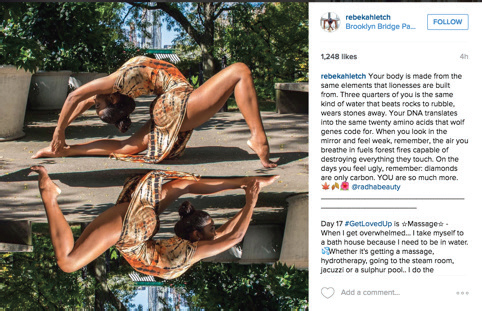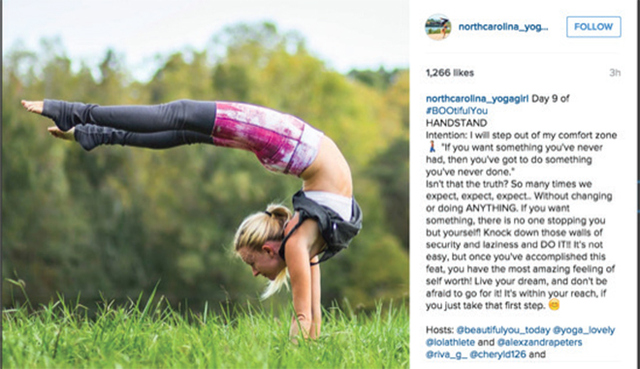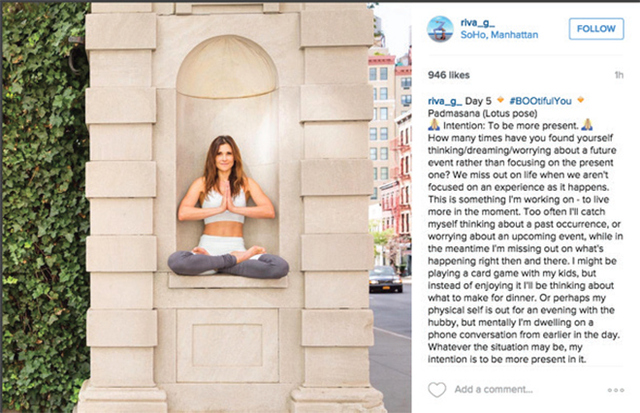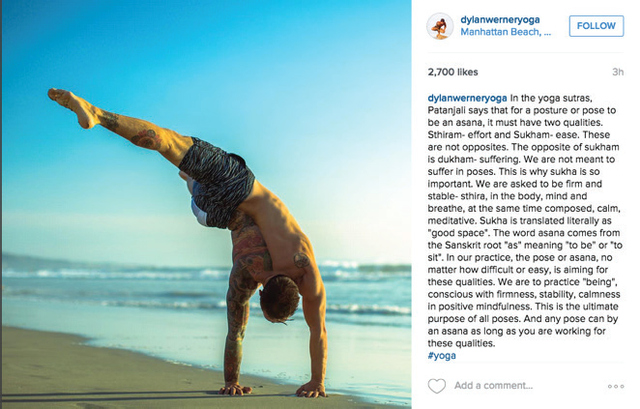From Elon Journal of Undergraduate Research in Communications VOL. 7 NO. 1Yoga On Instagram: Disseminating or Destroying Traditional Yogic Principles?
By
Elon Journal of Undergraduate Research in Communications 2016, Vol. 7 No. 1 | pg. 1/1
IN THIS ARTICLE
KEYWORDS
AbstractToday, more than 15 million Americans practice yoga, making the ancient Indian discipline synonymous with the Western society's culture of wellness. As a way to market themselves, practitioners and instructors of yoga have utilized Instagram – and its more than 300 million accounts – to virtually share their favorite poses, sequences, and yogic philosophies. This paper examines the popular culture of yoga on Instagram and how it relates to the ancient Indian traditions of which the practice was built upon. The study found that while some observed themes of yoga on Instagram reflected elements of traditional yogic principles, others did not. I. IntroductionWhen the hashtag yoga (#yoga) was searched on Instagram, a stream of more than 15 million posts emerged, a number that grows greater each day. Scroll through the images on that stream, and one will find it plastered with aesthetically appealing photographs of mostly young, beautiful, thin women demonstrating difficult contortionist postures including fancy headstands, arm balances, twisted binds, and perfect planks. This severe emphasis on image in the yoga world of Instagram has even become a way for practitioners and instructors of yoga to market themselves, resulting in lucrative business (Lieber, 2014). Overall image and presentation of yoga postures have become an intrinsic element of the perception of the yoga tradition as a whole (Jain, 2015). But what is the original meaning of the yoga tradition and how does it compare to how yoga is now portrayed on Instagram? Since yoga first made its way to the United States in 1805, public opinion of the ancient Indian practice has come a long way (Love, 2006). From being mocked and laughed at, to being scrutinized by the media, yoga has endured endless judgment. Finally in the 21st century, yoga has come to dominate the culture of wellness in Western society, specifically in the United States. Today, more than 15 million Americans practice yoga (Statistics Brain, 2015) and more than 300 million people have an Instagram account (Statista, 2015). The prominence of this social media platform has become a central location for yogis of all sorts to virtually share their favorite poses, sequences, and yogic philosophies. This paper examines the popular culture of yoga on Instagram and how it relates to the ancient Indian traditions of which yoga was built upon. The current author used the hashtag "yoga" (#yoga) to find images over the course of 10 separate days in October 2015 for content analysis. The author used the hashtag #yoga to find Instagram posts and selected the first 10 as under the category of "top posts" (Instragram, 2015). The study examined the content, including the image, the image's caption, and hashtags that were posted by the user as a comment. This study did not analyze any comments from the Instagram community; in this case, the "user" refers to Instagram account owners. This content was compared with core principles of yoga that have lasted more than 5,000 years since the emergence of yoga as a tradition and practice based on core values and teachings from traditional yogic texts, including Patanjali's Yoga Sutras, Pattabhi Jois' Yoga Mala, and B.K.S. Iyengar's Light on Yoga. II. Literature ReviewTo understand the research topic better, the author did literature review focusing on related communications theories, traditional yogic philosophy, and changes of yoga as it has adapted to Western society. Social Media TheoryNo research was found about the effect of Instagram on yoga as a traditional practice, even though more and more research continues to emerge about social media and its ramifications. One area of study recently focused on social media's effect on health and wellness. Two researchers found that social media has become a channel where audiences sought knowledge about health and wellness (Korda & Itani, 2013). More specifically, user-generated content, such as a platform like Instagram, "is key to successful media outreach" (Korda & Itani, 2013, p. 21). Walther (1996) explored user intentions in his reviews of computer meditated-communication (CMC) by introducing the theory of "selective self-presentation" in which users will inherently use CMC--which may be also applied to social media in this case--to optimally portray themselves to other users. Although Walther's studies were published before the social media revolution, his theory offers fundamental reasoning as to why social media has become so prominently self-absorbed and image-oriented, especially amongst the younger millennial generation (Stein, 2013). Instagram has emerged as a prominent social media platform for the manipulation and formation of personal image representation (Titlow, 2013). In convergence with a growing desire for health and wellness content, potential dangers emerge from these crossing trends. More recently, several studies have begun to unveil the potential dangers arising from the impact of social media on negative body image. Tiggemann and Zaccardo (2015) studied the link between body image and fitspiration, a play-on word, merging the words "fit" and "inspiration." Fitspiration uses "examples of good fitness as inspiration to attain a fitness goal" (Urban Dictionary, 2011). Tiggemann and Zaccardo (2015) found that although fitspiration does have a positive effect on inspiration, it also has a negative effect on body image and an increase in physical appearance comparison. Computer Mediated Communication TheorySocial awareness streams (SAS) are platforms such as Facebook, Twitter, or Instagram, where "users post short content items (such as status "messages," links, or media items) instantly available publicly, or semi-publicly" (Teodoro & Norman, 2013, p. 1). Walther (1996) recognized Computer Mediated Communication (CMC) as having the ability to surpass face-to-face (FtF) communication in his hyperpersonal model, which means that CMC has inherent value and power within communication (Walther, 1996). Modernday CMC includes social awareness streams and all forms of social media. Walther analyzed this dynamic through the traditional "Communications Process Model" of sender -receiver -channel -feedback. This Communications Process Model, which can easily be applied to Instagram, is an effective way to define the actors in the communication within Instagram. In the case of Instagram, the "user" is the "sender," who is producing and providing the content that will be consumed by the receiver. The receiver in this case refers to the Instagram community/audience viewing the content. According to Walther's "selective self-presentation" theory, users tend to present themselves in the best possible light, shedding insight into motivations of users to post what they post. "Selective self-presentation" says that users on communication platforms, such as Instagram, will naturally try to reach the goals of achieving a particular positive impression (Walther, 1996). In simple terms this theory suggests that users of CMC have the goal of manipulating their image to present themselves in the best light. Yoga PhilosophyB.K.S. Iyengar was an Indian-born yoga guru (in the traditional meaning of guru) who is known for helping to bring yoga to the Western world during the 20th century. Iyengar was born in India in 1918 and died at age 95 in 2014. His famous book Light On Yoga reveals core values and philosophy of the traditional practice. Sanskrit, the traditional language of Indian, Hinduism, and Buddhism, is used for yoga, too (Ager, 2015). The word yoga is derived from the Sanskrit root yuj, which translates to "yoke," meaning to bind, join, and attach. It also means union or communion. One of the core principles of yoga is self-discipline or spiritual discipline through which one may attain union with God or union with the higher "Self" (Phillips, 2009). Iyengar (1966) describes this union as "the true union of our will with the will of God" (p. 1). Although yoga is now widely disassociated from religion in the modern world, yoga was traditionally framed as a religious practice, very much in accordance with obtaining spiritual enlightenment through placing faith in God and seeking union with God and the universe (Iyengar, 1966). The Yoga Sutra is one of the oldest, most classical and traditional yogic texts and is still used to teach the practice of yoga in today's modern society. Written by the sage Patanjali around 400 C.E., the Yoga Sutra "is the guidebook of classical, or raja (royal), yoga and is made up of 195 aphorisms (sutras), or words of wisdom," (Rosen, 2014). In the Yoga Sutra, Patanjali introduces the eightfold path called Ashtanga, which translates in Sanskrit to "eight limbs" (ashta=eight, anga=limb). The Eight Limbs of Yoga are elaborate and include a depth of principles and practices. Major themes within the Eight Limbs include nonviolence, truthfulness, self-discipline, spiritual-discipline, contentment, study of the scared scriptures and one's Self, surrendering to God, sensory withdrawal, and concentration. The third limb is Asana, which refers to the physical practice. In yoga the body is the "temple of spirit" (Carrico, 2007) and is a vessel for which the individual may achieve the "Universal Self." "The yogi conquers the body by the practice of asanas and makes it a fit vehicle for the spirit" (Iyengar, 1966 p. 41). Asana has become the most prominent limb of modern yoga, used as a means to achieve greater physical wellbeing and a more desirable body type (Jain, 2015). The fourth limb is called Pranayama, which refers to "breath control" and is literally translated as "life force extension" (Carrico, 2007). The breath drives the practice of yoga, and Pranayama is generally inseparable from Asana. The final and eighth limb is Samadhi, which Patanjali describes as "a state of ecstasy" (Carrico, 2007) and what Iyengar refers to as a "state of supreme bliss" (Iyengar, 1966, p. 51). The Eight Limbs of Yoga were not specifically coded quantitatively within the research; however, themes from within the Eight Limbs were observed during the open coding qualitative process. Shri K. Pattabhi Jois is another renowned Indian yoga teacher known for helping to bring yoga to the West. Jois created the popular Vinyasa flow of Ashtanga yoga, which has become a model for several fitnessoriented yoga classes in the modern era. Jois created the Asanas of Ashtanga as a means for entering the Eight Limbs of Yoga, outlined in Yoga Mala originally published in 1962. Jois defines yoga as the "path, or way which we follow or by means of which we can attain something" (Jois, 2002, p. 4) and is "the means to the realization of one's true nature" (Jois, 2002, p. 5). Jois asks, "How can we make the mind one-pointed so that we may see the Universal Self? This is what ashtanga yoga teaches" (Jois, 2002, p. 6). The Commercialization of YogaLove (2006) examined yoga's arduous journey through American media, from being mocked and made fun of, to being viciously attacked and scrutinized at the end of the 19th century, during an era of immigration and extreme xenophobia. Love uncovers the story of the media's portrayal from times when "yoga has been feared, loathed, mocked, kicked to the fringes of society, associated with sexual promiscuity, criminal fraud, and runaway immigration" (p. 81) to currently a time of extreme attraction and lucrative business. Jain (2015) explored how yoga had transitioned from a countercultural practice to a pop culture phenomenon through yogic entrepreneurs. Pop culture has increased the demands of a global market for yoga, reflecting a heightened desire for beauty, flexibility, and fitness as well as goals of stress reduction (Jain, 2015). Jain (2015) described the transition between premodern yoga systems and yoga in today's society, "When we think of yoga today, most of us envision spandex-clad, perspiring, toned bodies brought together in a room filled with yoga mats and engaged in a fitness ritual set apart from day-to-day life" (p. 1). In several ways, Instagram has become another modern tool for yoga and yoga entrepreneurs to "package" the practice, and has been marketed as a means for self-development (Jain, 2015). Deshpandé, Herman, and Lobb (2013) also studied the branding of yoga, highlighting yoga "gurus." Guru is the Sanskrit word for teacher, guide, or master. Deshpandé, Herman, and Lobb (2013) distinguished the difference between the traditional yogic meaning of "guru" and the modern meaning of "guru," which has come to signify celebrities within the yoga community who use their credibility to create a brand that sells. The branding of yoga has led to a six billion dollar industry. However, Shukla (2010, para. 1) pointed out that this type of fitness and image-oriented branding of yoga has created a controversy in the yoga community, especially amongst more traditional practitioners, such as Hindus in America who associate yoga with having Hindu roots. Modern perceptions of yoga have been directly associated with greater health, wellness, physical strength, beauty, and happiness (Jain, 2015). However, within Jois' explanation of the Eight Limbs of Yoga, it is explicitly stated that practicing yoga for these reasons will not fulfill the true path to yogic enlightenment. As stated in Yoga Mala, "Practicing yoga for the sake of one's health, a firm body, or enjoyment is not the right approach," (Jois, 2002, p. 26). Yoga in modern society is often used as a tool for self-development. Although traditional practice places a high importance on achieving one's highest Self, freeing one's Self from the dominance of the ego is also a core yogic principle (Iyengar, 1966). These are examples of the disconnect between principles of the traditional yoga practice and the way yoga is framed, practiced, and viewed today in modern Western society. With an increasingly interconnected world reliant and active on social media, and with yoga's increasing popularity in the West, it is important to assess the relationship between yoga's popular presence on Instagram and these core principles of yoga as taught by traditional yoga gurus. To guide this study, the following three research questions were asked:
III. MethodThe study content analyzed 100 yoga posts on Instagram. The author searched Instagram with the hashtag yoga (#yoga) and selected the top 10 posts under the category "top posts" over 10 random days in October 2015. Occasionally, posts selected had little or nothing to do with yoga, but simply classified as such because the users would tag #yoga, for whatever reason, possibly to gain more circulation/likes. These posts were discarded for this study, along with yoga videos. According to Instagram (2015), "top posts appear on trending hashtags and places to show you some of the popular posts tagged with that hashtag or place," (specific location). The algorithm used to curate these posts was not found. This study analyzed three elements of posts: images, captions, and hashtags a user employed when posting the image. First, all 100 static images were checked for the presence of the following five characteristics:
In addition to this quantitative coding method, a qualitative open coding method was also applied to the visual images to look for additional patterns, trends, and nuances. The open qualitative method was also done by analyzing caption text and hashtags included by the user. IV. Findings and DiscussionBased on the fi ve-category content analysis, the author found at least 65% of images have at least one of the fi ve characteristics, as shown in Table 1. Clothing: Among the 100 images, 65% of the images in the sample depicted an individual wearing minimal clothing, often revealing a hyper-toned/fit body that was generally very thin and slender. When it comes to a thin/fit body, it reached 86%. Only two images in the data sample depicted overweight practitioners (Refer to Figure 1 and 2). Advanced posture and body type: 80% of the images in the sample depicted the practitioner in an advanced posture. Thin/fit body types were more likely to display an advanced posture than other types. Handstands and arm balance variations were the main types of advanced poses being demonstrated, placing a high importance on the physical/asana element of the practice, whereas virtually none of the other Eight Limbs were present. Physical strength was conveyed more often through images than captions or hashtags that used #strength, #fit, #getfit #yogastrong, or #corestrength. Gender: 76% of the images in the sample contained women. Yoga has been marketed in today's Western society mainly for females, as represented by modern celebrity gurus, like former model turned yogi Tara Stiles (Deshpandé et al., 2013). However, in traditional yoga, women were not allowed to partake in the practice until the 20th century (Steensma, 2014). Outdoor setting: Within the sample, 72% of images were depicted in an outdoor setting, with nature being an integral aesthetic theme. This represents another direct disparity between traditional yoga and yoga on Instagram, as the traditional practice advised practitioners to only practice indoors and refrain from being exposed to open air for at least one half hour after practicing (Jois, 2002). V. AnalysisBased mainly on the aesthetics of each image, the presence of "selective self-presentation" was overwhelmingly present within the data sample. The majority of posts within the sample depicted nearly fl awless bodies and images that were naturally appealing to the eye. The images were in optimal perfection. The majority of images in the sample were high quality, well framed, colored and composed, and depicted nearly fl awless human fi gures demonstrating advanced yoga postures, as shown in Figure 3 and 4. Figure 3. A high-quality, well-framed, colored and composed, and depicted nearly flawless human figure The theme of health/wellness in accordance with inspiration was also a prominent pattern that emerged. "Fitspiration" surfaced regularly within the majority of posts, mainly as the hashtag (#fitspiration) along with #fitspo, #inspiration, #yogainspiration, #inspiredyogi, #beinspired, and #motivation. In addition, many of the textual captions encompassed themes regarding inspiration and motivation. The user would often post a longer form of caption as if she were directly speaking to the receiver. This trend of encouraging the receiver to practice yoga is somewhat related to the second limb of yoga Niyama, or self-discipline. Niyama was not once explicitly cited within the data sample, but the theme of proactivity and disciplined work ethic was common within user captions, as shown in Figure 5 on the next page. Figure 4. A high-quality, well-framed, colored and composed, and depicted nearly flawless human figure Many other captions in the sample refl ected the same theme: "If you want something, there is no one stopping you but yourself . . . Live your dream and don't be afraid to go for it!" (@northcarolina_ yogagirl, Instagram, October 26, 2015). The theme of "living one's dream" was one that consistently surfaced throughout the sample along with several hashtags related to this pattern, including #liveyourlife, #liveyourdream, and #followyourdreams. #fitspiration, which appeared frequently, has been shown to have a negative effect on body image (Tiggemann et al., 2015). This emphasis on fitspiration, combined with the fit/thin body type dominantly represented within top yoga posts on Instagram, demonstrates a sharp contrast to traditional yogic principles. Jois (2002) said that yoga should not be practiced for the sake of outward appearance of physicality and specifi cally discourages yogis from practicing yoga for physical strength and physical fitness. The only concrete representation of the Eight Limbs in their definitive form was present within the Asana and Pranayama limbs, highlighting the physical practice and the life force breath used to guide the physical practice. These limbs were minimally present. Some poses, in which the sender provided a step-bystep guide for the receiver to practice the pose, contained the Sanskrit word for the pose. In the image below, the user @laurasykora challenged her followers to try the pose Eka Pada Galavasana, or "Flying Pigeon" (See Figure 6). Although the user described the pose clearly while accurately citing and emphasizing the traditional Sanskrit language for demonstration, traditional teachings advise yoga learners against the general practice of learning yoga postures from images: "Yoga should never be learned from reading books or looking at pictures. It should only be learned under the guidance of a Guru who knows the yogic science and is experienced in its practice" (Jois, 2002, p. 28). One recurring theme in the sample was the value of being present and content. These are core principles of traditional yoga and highly emphasized in classic yogic text. These goals may be achieved through the Eight Limbs and experienced in full form during the final limb, Samadhi. During Samadhi "there remains no sense of ‘I' or ‘mine' as the working of the body, the mind and the intellect have stopped as if one is in deep sleep," (Iyengar, 1966, p. 52). Although Samadhi was never directly referenced, messages implying this were presented, primarily as the theme of being fully present in contentment (See Figure 7). User @riva_g_ captioned one post with "Intention: to be more present . . . This is something I'm working on to live more in the moment. Whatever the situation may be, my intention is to be more present in it" (@riva_g_, Instagram, October 21, 2015). Although several of the messages in the captions demonstrated an attempt by the user to connect to principles within the traditional practice, there was a clear disconnect between the two. Rarely any of them placed an emphasis on clear-cut yogic themes within the traditional texts. However there were exceptions to this trend. For example, the user @dylanwerneryoga directly cited Patanjali in the caption of one of his posts: "In the yoga sutras, Patanjali says that for a posture to be an asana it must have two qualities. Sthirameffort and Sukhamease" (@dylanwerneryoga, Instagram, October 28, 2015). This user demonstrates connectivity to the traditional practice and an active effort to incorporate these principles into his generated Instagram content (See Figure 8 on the next page). Self-development was a major trend while emphasizing both physical and mental health with overall wellbeing as the main goal. Encouragement and inspiration to achieve this goal was prominent, with a considerable signifi cance placed on happiness. Images, captions, and hashtags were used to inspire viewers to achieve optimal physical ability, especially through images that refl ected not only strong bodies, but also a sense of joy, peace, and fulfi llment. This is consistent with the traditional practice, which emphasizes the importance of achieving optimal physical and mental wellbeing. Iyengar (1966) discussed this important element of the yoga practice when he wrote, "To the yogi his body is the prime instrument of attainment. If this vehicle breaks down, the traveler cannot go far. If the body is broken by ill-health, the aspirant can achieve little" (p. 24). While images refl ected this principle, however, they did not fully recognize the true purpose for achieving optimal wellbeing. In traditional yoga, the health of an individual is only used as a means for connecting to a higher state of enlightenment, with both the "Universal Self" and God (Iyengar, 1966). A healthy body and mind are deemed crucial for achieving "supreme bliss" and for connecting with God, which was not a theme present within the selected sample. VI. ConclusionThe study found themes and values from the top yoga posts on Instagram, such as fitness, fitspiration, inspiration, being present, and happiness. While these themes mirror elements within traditional teachings, very few of the yoga posts analyzed directly refl ect traditional teachings. The findings mirror previous research that has shown how yoga has transformed from ancient India to the present day, coherent with the West's emphasis on yoga as a physical practice for the obtainment of fitness, health, and stress-reduction. The image-based culture of yoga on Instagram also suggests that this social media platform has become another tool for yoga instructors, "gurus," and practitioners to brand and market themselves. Yoga on Instagram has become far more about the physical body, and its physical appearance, than anything else. This trend is in extreme confl ict with the teachings of traditional yoga that discourages using yoga to attain such goals of physical strength and beauty. Although having a strong and healthy body is important to the yoga practice, the teachings write that it should be used only as a vehicle to achieve a higher power, a theme that was almost nonexistent within the examined sample. AcknowledgementsThis author is thankful to Glenn Scott, associate professor at Elon University, for his supervision and advice, without which the article could not be published. The author would also like to thank Julie Lellis, associate professor and associate department chair at Elon University, for her guidance and inspiration. The author also appreciates numerous reviewers who have helped revise this article. ReferencesAger, S. (2015). Sanskrit. The Online Encyclopedia of Writing Systems & Languages. Retrieved from http://www.omniglot.com/writing/sanskrit.htm. Carrico, M. (2007, August 28). Get to know the eight limbs of yoga. Yoga Journal. Retrieved from http://www.yogajournal.com/article/beginners/the-eight-limbs/ Deshpandé R., Herman K., & Lobb A. (2013). Branding Yoga. Harvard Business School, 9 (512-025). 1-13. Epstein, D.A., Fogarty, J., & Munson S.A. (2014). Failures in sharing personal data on social networking sites. Proceedings of the 2014 ACM International Joint Conference on Pervasive and Ubiquitous Computing: Adjunct Publication, 695-698. Instagram. (2015). What are Top Posts on hashtag or place pages? Retreived from https://help.instagram.com/701338620009494?ref=related. Iyengar, B.K.S. (1966). What is yoga? In, Light on yoga (19-53). New York: Schocken Books Inc. Jain, A.R. (2015). Selling yoga: From counterculture to pop culture. New York: Oxford University Press. Jois, S.K.P. (2002). Yoga mala (3-31). New York: North Point Press. Korda, H., & Itani, Z. (2013). Harnessing social media for health promotion and behavior change. Healthy Promotion Practice, 14(1). 15-23. Lieber, C. (2014). Inside the lucrative world of yoga instagrammers. Racked. Retrieved from http://www.racked.com/2014/3/12/7613191/how-yoga-on-instagram-turned-into-a-business. Love, R. (2006). Fear of yoga. Columbia Journalism Review, 45(4), 80-90. Phillips, S.H. (2009), Yoga, Karma, and Rebirth. New York: Columbia University Press. Rosen, R. (2014, August 28). Who was Patanjali? Yoga Journal. Retrieved from http://www.yogajournal.com/article/philosophy/who-was-patanjali/. Shukla, S.A. (2010). The origins and ownership of yoga. The Huffington Post. Retrieved from http://www.huffingtonpost.com/suhag-a-shukla-esq/the-origins-and-ownership_b_791129.html. Statista: The Statistics Portal. (2015). Leading social networks worldwide as of August 2015, ranked by number of active users (in millions) (Data File). Retrieved from http://www.statista.com/statistics/272014/global-social-networks-ranked-by-number-of-users/ Statistics Brain (2015). Yoga Statistics (Data File). Retrieved from http://www.statisticbrain.com/yogastatistics/ Steensma, D. (2014). A brief history of modern yoga. The Yoga Channel. Retrieved from http://theyogachannel.net/a-brief-history-of-modern-yoga/. Stein, J. (2013). Millennials: The me me me generation. Time. Retrieved from http://time.com/247/millennialstheme-me-me-generation/. Teodoro, R., & Naaman, M. (2013). Fitter with twitter: Understanding personal health and fitness activity in social media. Association for the Advancement of Artificial Intelligence, ICWSM, 611-620. aaai.org Tiggemann, M. & Zaccardo, M. (2015). "Exercise to be fit, not skinny": The effect of fitspiration imagery on women's body image. Science Direct: Body Image, 15, 61-67. Titlow, J.P. (2013). #Me: Instagram narcissism and the scourge of the selfie. Readwrite. Retreived from http://readwrite.com/2013/01/31/instagram-selfies-narcissism. Urban Dictionary. (2011). Fitspiration. Retrieved from http://www.urbandictionary.com/define.php?term=fitspiration. Walther, J.B. (1996). Computer-mediated communication: Impersonal, interpersonal, and hyperpersonal interaction. Communication Research, 23(1), 3-43. Suggested Reading from Inquiries Journal
Inquiries Journal provides undergraduate and graduate students around the world a platform for the wide dissemination of academic work over a range of core disciplines. Representing the work of students from hundreds of institutions around the globe, Inquiries Journal's large database of academic articles is completely free. Learn more | Blog | Submit Latest in Business & Communications |




























